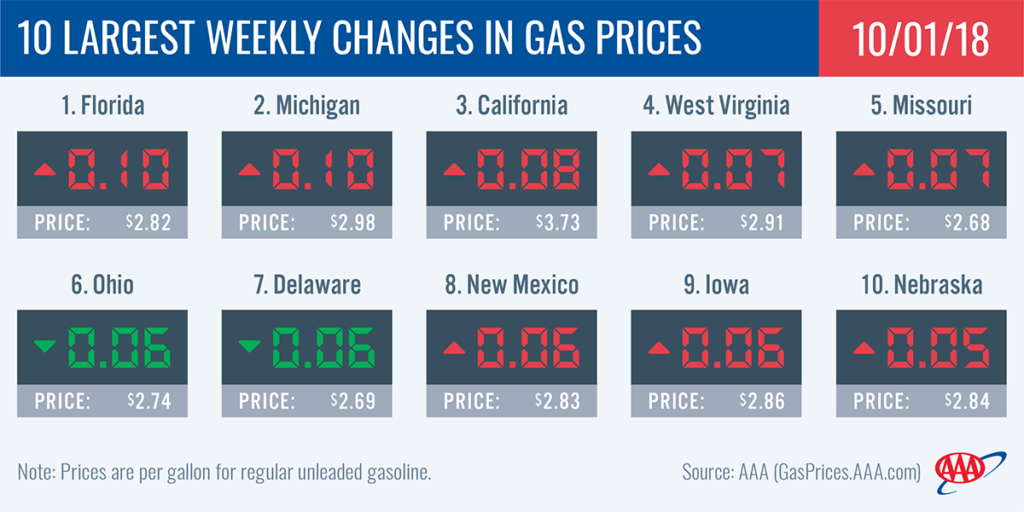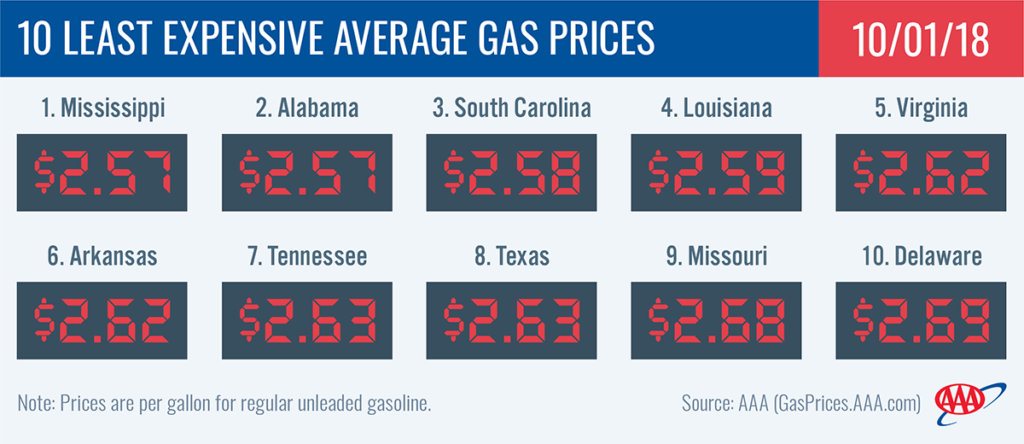Despite gasoline demand dropping to 9.0 million b/d and inventories growing to 235.7 million bbl, according to the latest Energy Information Administration (EIA) data, the national gas price average has increased three cents on the week to land at $2.88 – a pump price not seen at the national average since mid-July.
“The last quarter of the year has kicked off with gas prices that feel more like summer than fall,” said Jeanette Casselano, AAA spokesperson. “This time of year, motorists are accustomed to seeing prices drop steadily, but due to continued global supply and demand concerns as well as very expensive summertime crude oil prices, motorists are not seeing relief at the pump.”
Today’s national gas price average ($2.88) is the most expensive for the beginning of October since 2014. The average is four cents more than a month ago and 32 cents more than a year ago.
Quick Stats
- The nation’s top 10 least expensive markets are: Mississippi ($2.57), Alabama ($2.57), South Carolina ($2.58), Louisiana ($2.59), Virginia ($2.62), Arkansas ($2.62), Tennessee ($2.63), Texas ($2.63), Missouri ($2.68) and Delaware ($2.69).
- The nation’s top 10 largest weekly changes are: Florida (+10 cents), Michigan (+10 cents), California (+8 cents), West Virginia (+7 cents), Missouri (+7 cents), Ohio (-6 cents), Delaware (-6 cents), New Mexico (+6 cents), Iowa (+6 cents) and Nebraska (+5 cents).
Great Lakes and Central
Refinery maintenance across the Great Lakes and Central states continues to contribute to higher gas prices in the region. In fact, refinery utilization in the region dropped to 83 percent, which is the lowest rate since April 2016. On the week, four states have gas prices that are a nickel or more expensive: Michigan (+10 cents), Missouri (+7 cents), Iowa (+6 cents) and Nebraska (+5 cents). For a few days last week, Michigan’s gas price returned to $3.00 – a price point the state has not seen in six weeks. Once refineries wrap-up maintenance, gas prices in the region are expected to ease, though maintenance could last through November.
Three states in the region are benefitting from cheaper pump prices at the start of the week: Ohio (-6 cents), Indiana (-4 cents), Kentucky (-3 cents) and Illinois (-3 cents).
The positive news is that Great Lakes and Central states’ gasoline inventories remain at a healthy 52.2 million bbl level. If inventories fall dramatically, motorists could see prices spike even more in the region.
Mid-Atlantic and Northeast
States in the Mid-Atlantic and Northeast region are seeing fluctuation on the week. For most states, that means small jumps or declines of a few pennies. West Virginia (+7 cents), Delaware (-6 cents) and Tennessee (+5 cents) saw the largest changes in gas prices on the week in the region. With some gasoline supply likely coming from the Mid-West, West Virginia and Tennessee’s spikes can be tied to refinery maintenance in that region.
With the addition of 1.6 million bbl, gasoline inventories sit at their highest level – 67.4 million bbl – for the Mid-Atlantic and Northeast this year. The large increase helped to minimize gas price increases for most states. The last time levels exceeded the 67.4 million bbl was mid-June 2017.
South and Southeast
Most states in the South and Southwest region saw small – one to four cent – increases with the exception of Florida (+10 cents) and New Mexico (+6 cents). Given that gasoline inventories in the region sit at a large 7.2 million bbl year-over-year surplus, the unseasonal price pump jumps are likely due to more expensive crude oil prices, which account for 50 percent of a retail price. Gas stations are just now likely passing on the increased costs of more expensive gasoline.
Three states in the region have the smallest year-over-year change in gas price of all states in the country: Georgia (+10 cents), South Carolina (+16 cents) and Alabama (+16 cents).
On the week, gasoline inventories built by 920,000 bbl to total at 81.5 million bbl.
Rockies
Utah and Idaho continue to see gas prices decline this week, with each seeing a four-cent decrease. Wyoming (-1 cent) also saw a drop. Conversely, motorists in Montana (+5 cents) and Colorado (+2 cents) are paying more on the week.
Compared to this summer, Colorado and Montana are seeing more expensive fall pump prices, which could be tied to higher costs for gas stations to purchase gasoline, due to higher crude oil prices in the summertime.
According to the EIA, gasoline inventories grew by 220,000 bbl to register at 6.7 million bbl. Despite this being a healthy inventory level for this time of year, it is not contributing toward cheaper gas prices for some states in the region.
West Coast
Pump prices in the West Coast region are among the highest prices for retail gasoline in the nation, with six of the region’s states represented in the nation’s top 10 most expensive list. Hawaii ($3.80) is the nation’s most expensive market, followed by California ($3.73), Washington ($3.40), Alaska ($3.30), Oregon ($3.26), Nevada ($3.22) and Arizona ($2.88). All prices in the region have increased on the week, with California (+8 cents) leading the way. Alaska and Nevada each increased three cents, while Hawaii and Washington each increased two cents.
The EIA’s weekly petroleum status report showed West Coast motor gasoline stocks fell by a sizeable 1 million bbl to 27.9 million bbl during the week that ended on September 21. Stocks are 800,000 bbl lower than where they were at this time last year, which could lead to price volatility if there are any supply shocks in the region this week.
Oil market dynamics
At the close of Friday’s formal trading session on the NYMEX, WTI increased $1.13 to settle at $73.25. Crude prices rallied last week due to concerns around the impact of U.S.-imposed sanctions on Iran and economic collapse in Venezuela on global crude supply this fall. The increase in crude prices occurred despite crude oil inventories increasing to 396 million bbl last week after five consecutive weeks of decline, according to EIA’s report for the week ending on September 21. Domestic crude inventories are now roughly 75 million bbl lower than were they were at this time last year. The new crude data from EIA will likely leave the market searching for additional evidence of supply constraints, including this week’s EIA report, which could push crude prices even higher this fall.
In related news, Baker Hughes, Inc. reported that the U.S. lost three oil rigs last week, bringing the total to 863. However, when compared to last year at this time, there are 113 more rigs now than in 2017.
Motorists can find current gas prices along their route with the free AAA Mobile app for iPhone, iPad and Android. The app can also be used to map a route, find discounts, book a hotel and access AAA roadside assistance. Learn more at AAA.com/mobile.



